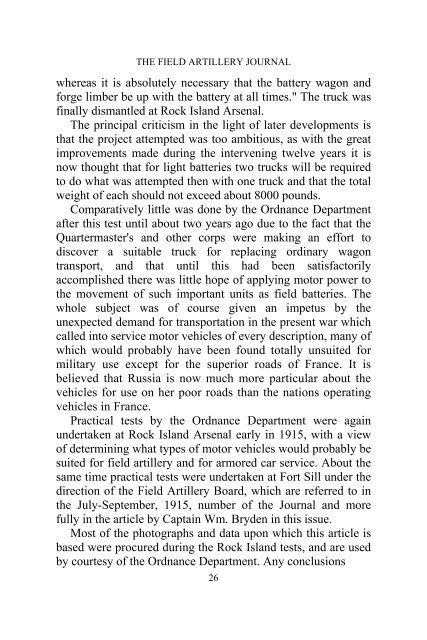the field artillery journal - Fort Sill - U.S. Army
the field artillery journal - Fort Sill - U.S. Army
the field artillery journal - Fort Sill - U.S. Army
Create successful ePaper yourself
Turn your PDF publications into a flip-book with our unique Google optimized e-Paper software.
THE FIELD ARTILLERY JOURNAL<br />
whereas it is absolutely necessary that <strong>the</strong> battery wagon and<br />
forge limber be up with <strong>the</strong> battery at all times." The truck was<br />
finally dismantled at Rock Island Arsenal.<br />
The principal criticism in <strong>the</strong> light of later developments is<br />
that <strong>the</strong> project attempted was too ambitious, as with <strong>the</strong> great<br />
improvements made during <strong>the</strong> intervening twelve years it is<br />
now thought that for light batteries two trucks will be required<br />
to do what was attempted <strong>the</strong>n with one truck and that <strong>the</strong> total<br />
weight of each should not exceed about 8000 pounds.<br />
Comparatively little was done by <strong>the</strong> Ordnance Department<br />
after this test until about two years ago due to <strong>the</strong> fact that <strong>the</strong><br />
Quartermaster's and o<strong>the</strong>r corps were making an effort to<br />
discover a suitable truck for replacing ordinary wagon<br />
transport, and that until this had been satisfactorily<br />
accomplished <strong>the</strong>re was little hope of applying motor power to<br />
<strong>the</strong> movement of such important units as <strong>field</strong> batteries. The<br />
whole subject was of course given an impetus by <strong>the</strong><br />
unexpected demand for transportation in <strong>the</strong> present war which<br />
called into service motor vehicles of every description, many of<br />
which would probably have been found totally unsuited for<br />
military use except for <strong>the</strong> superior roads of France. It is<br />
believed that Russia is now much more particular about <strong>the</strong><br />
vehicles for use on her poor roads than <strong>the</strong> nations operating<br />
vehicles in France.<br />
Practical tests by <strong>the</strong> Ordnance Department were again<br />
undertaken at Rock Island Arsenal early in 1915, with a view<br />
of determining what types of motor vehicles would probably be<br />
suited for <strong>field</strong> <strong>artillery</strong> and for armored car service. About <strong>the</strong><br />
same time practical tests were undertaken at <strong>Fort</strong> <strong>Sill</strong> under <strong>the</strong><br />
direction of <strong>the</strong> Field Artillery Board, which are referred to in<br />
<strong>the</strong> July-September, 1915, number of <strong>the</strong> Journal and more<br />
fully in <strong>the</strong> article by Captain Wm. Bryden in this issue.<br />
Most of <strong>the</strong> photographs and data upon which this article is<br />
based were procured during <strong>the</strong> Rock Island tests, and are used<br />
by courtesy of <strong>the</strong> Ordnance Department. Any conclusions<br />
26

















